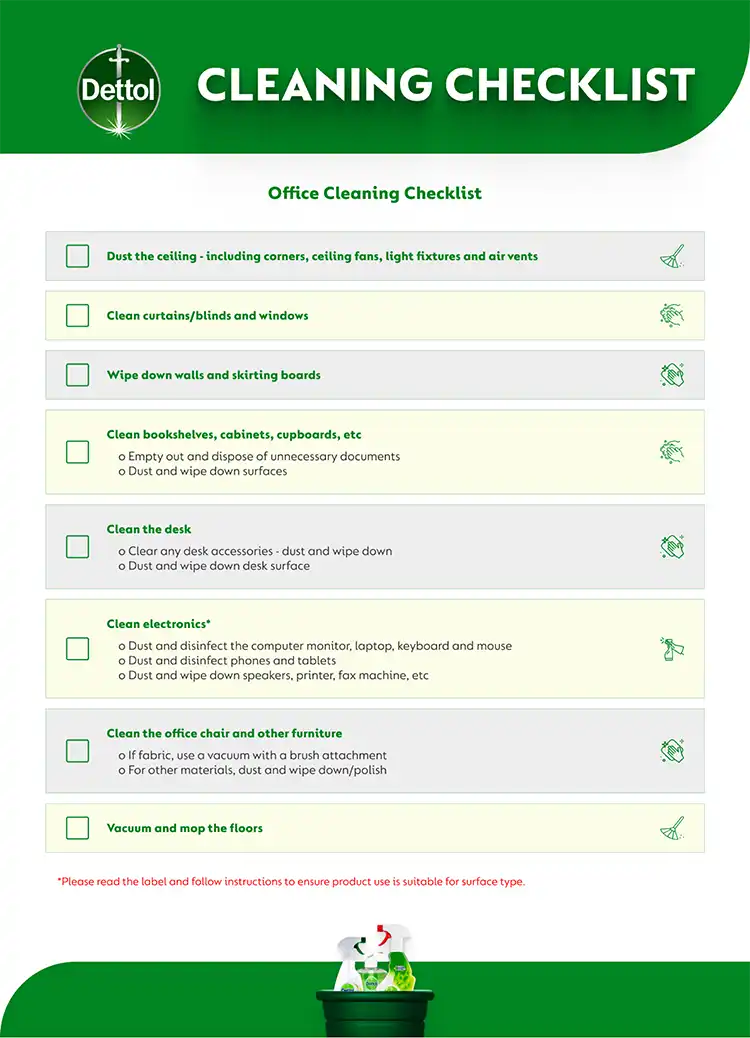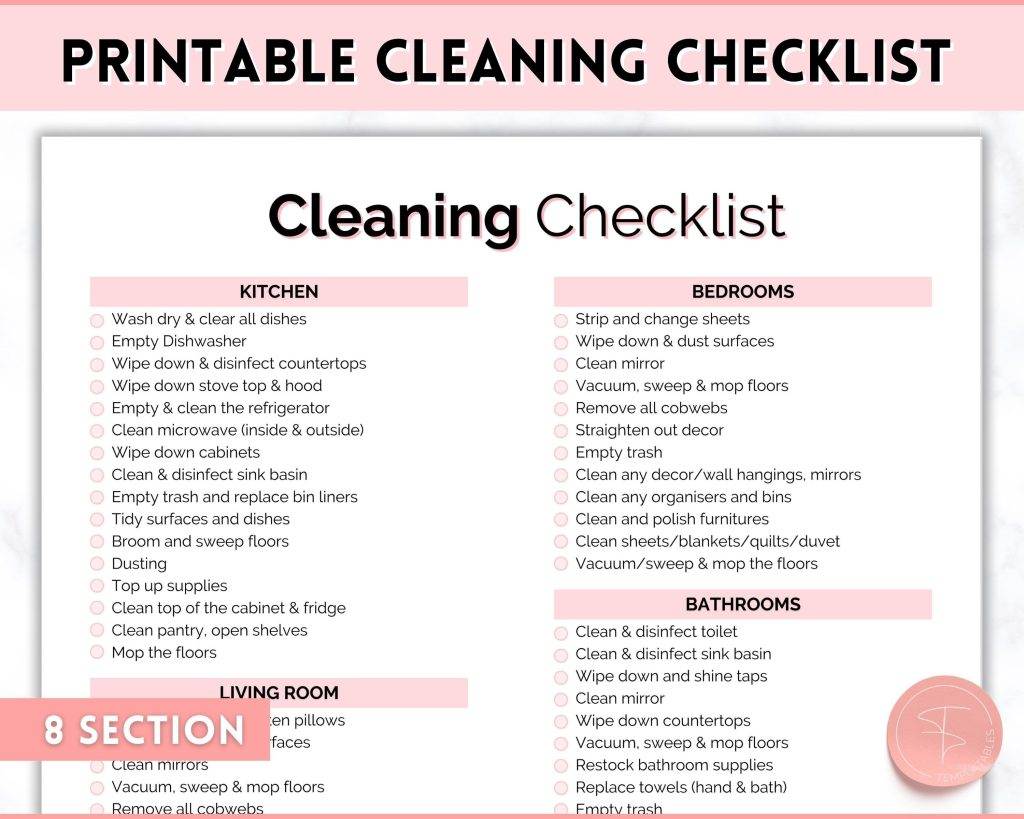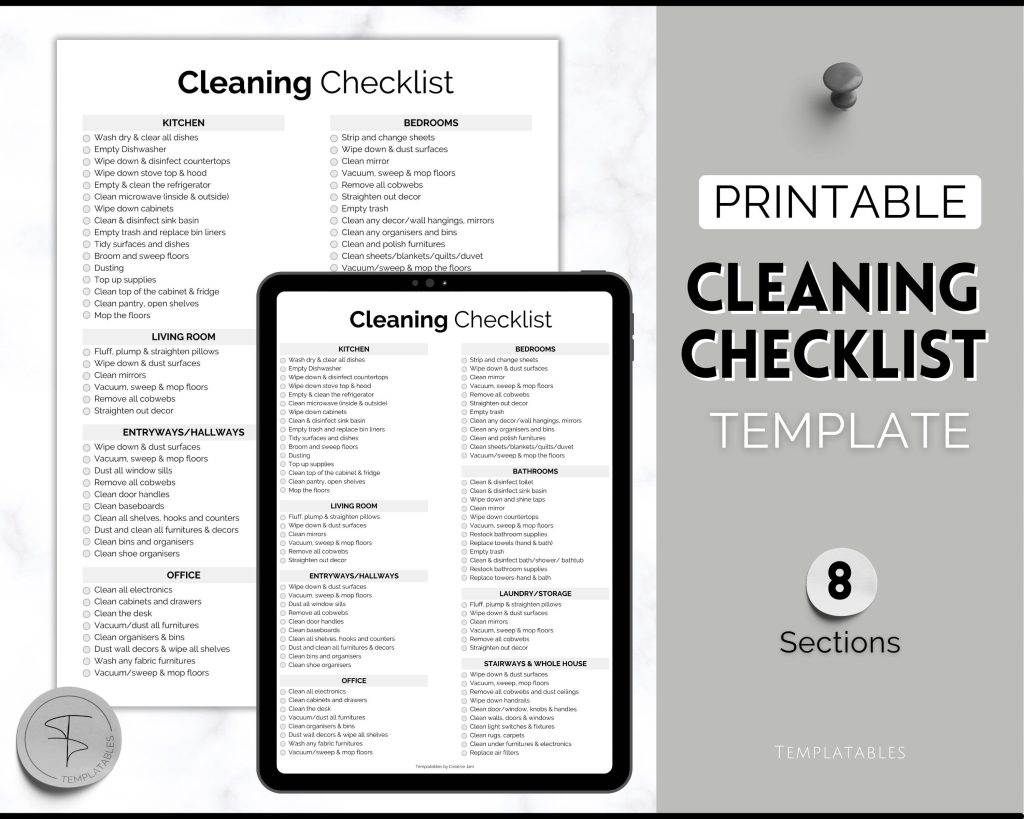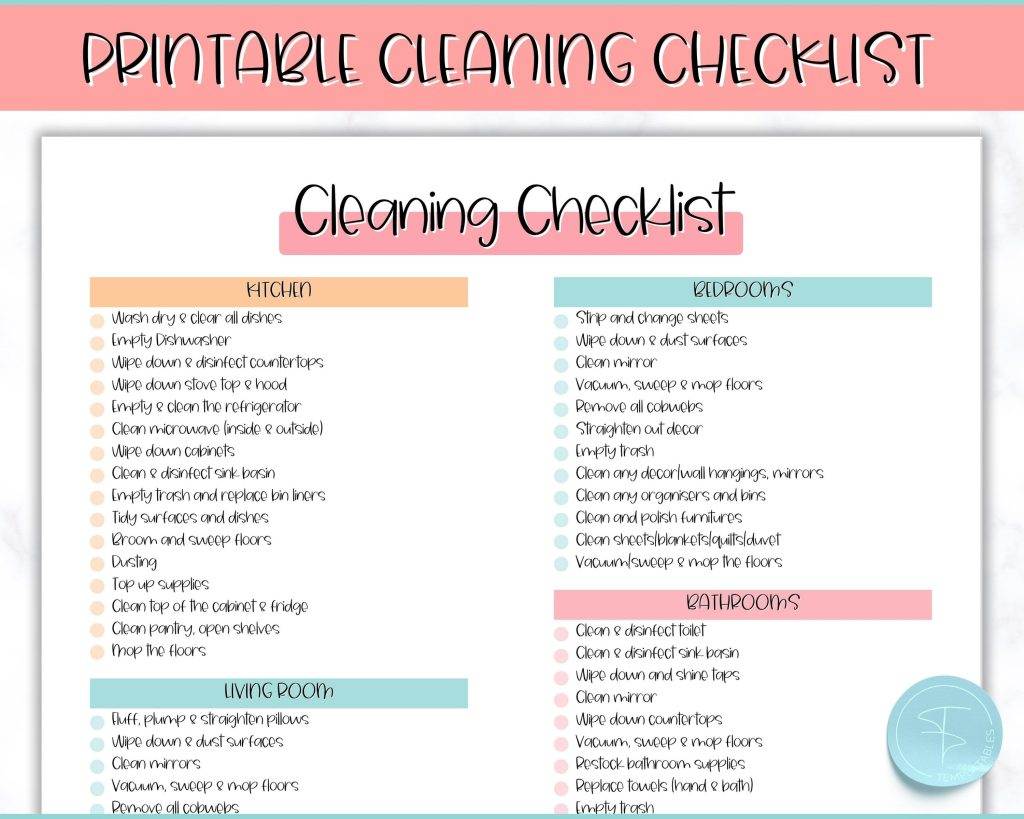21September 2023
Are you tired of spending endless hours cleaning your office space without seeing the desired results? Look no further! In this article, we will guide you through mastering the art of office cleaning by providing you with a handy checklist. Whether you are a business owner, office manager, or cleaning professional, this comprehensive checklist will ensure that every nook and cranny of your workspace is sparkling clean and organized. Say goodbye to messy desks, dusty corners, and cluttered common areas as we equip you with the knowledge and tools to transform your office into a pristine and inviting environment. It’s time to take the stress and guesswork out of office cleaning and achieve a spotless workspace. So grab your cleaning supplies and get ready for a cleaner and more productive office!

This image is property of integrityservicecompanies.com.
1. Determining the Scope of Cleaning
Identifying the Size and Layout of the Office
The first step in creating an effective office cleaning checklist is to identify the size and layout of your office space. By understanding the specific areas that need attention, you can ensure that nothing is overlooked. Take note of the number of rooms, cubicles, conference rooms, and other spaces that require cleaning.
Taking Note of High-Traffic Areas
High-traffic areas such as entranceways, hallways, and break rooms often require more frequent cleaning due to the constant flow of people. These areas tend to accumulate dirt, dust, and debris quickly. By paying attention to these spots on your checklist, you can ensure they receive the necessary attention.
Assessing Specific Cleaning Needs
Each office has unique cleaning needs based on the nature of the business and the activities that take place within the space. Assess the specific cleaning needs of your office, such as whether you deal with sensitive materials that require specialized cleaning techniques or if there are any areas prone to spills or stains that need extra attention. This will help you tailor your checklist to address these specific needs.
2. Establishing Cleaning Frequencies
Considering Daily Cleaning Tasks
Certain cleaning tasks should be performed on a daily basis to maintain a clean and hygienic office environment. These tasks may include emptying trash bins, wiping down surfaces, and sanitizing high-touch areas. By including these tasks in your daily cleaning checklist, you can ensure that the office remains tidy and presentable throughout the day.
Determining Weekly Cleaning Tasks
While some cleaning tasks only need to be performed daily, others can be scheduled on a weekly basis. This might include vacuuming or mopping floors, cleaning windows, or dusting hard-to-reach areas. By spreading these tasks out throughout the week, you can ensure that the office is consistently cleaned without overwhelming your cleaning crew.
Planning Monthly or Seasonal Cleaning Tasks
Certain cleaning tasks, such as deep cleaning carpets, sanitizing air vents, or washing curtains, only need to be performed on a monthly or seasonal basis. By planning these tasks in advance and including them in your cleaning schedule, you can maintain a thorough level of cleanliness in your office. Allocating specific times for these tasks ensures that they are not overlooked or forgotten.
3. Gathering the Essential Cleaning Supplies and Equipment
Creating a Checklist of Cleaning Supplies
To effectively clean your office, you’ll need to ensure you have all the necessary supplies. Create a checklist of cleaning supplies, including essential items such as disinfectants, all-purpose cleaners, microfiber cloths, mops, brooms, and vacuum cleaners. Having a well-stocked supply of cleaning products is crucial to maintaining a clean and healthy work environment.
Ensuring Availability of Cleaning Equipment
In addition to cleaning supplies, it’s important to have proper cleaning equipment readily available. Check that your vacuum cleaners are in good working condition, ensure you have enough mop heads and broom handles, and make sure your cleaning equipment is well-maintained. This will save time and ensure that your cleaning crew can efficiently complete their tasks.
Organizing Storage for Cleaning Materials
Keeping your cleaning supplies organized and accessible is essential for efficiency. Create designated storage areas for cleaning materials, making sure they are easily accessible to your cleaning crew. Properly labeled storage shelves or cabinets will make it easier to find and restock supplies when needed, eliminating confusion and minimizing downtime during the cleaning process.
4. Planning a Cleaning Schedule
Creating a Regular Cleaning Routine
Establishing a regular cleaning routine is vital to maintaining a consistently clean and organized office. Determine how often each task needs to be performed based on its priority and designate specific days or times for those tasks. This could include daily tasks like emptying trash bins or weekly tasks like vacuuming the entire office. By creating a routine, you can ensure that each area is cleaned regularly and nothing is overlooked.
Allocating Specific Cleaning Tasks
Assigning specific tasks to your cleaning crew is an effective way to ensure that each area of the office receives the attention it needs. Divide the cleaning responsibilities among your team members, clearly outlining their roles and areas of focus. This will help streamline the cleaning process and ensure that every task is completed thoroughly.
Delegate Responsibilities or Assign Cleaning Crew
Depending on the size of your office, you may need to delegate cleaning responsibilities to specific individuals or hire a professional cleaning crew. Consider the size and complexity of your cleaning needs when determining whether to assign cleaning tasks to internal staff or outsource the work. Regardless of the approach, open communication and clear expectations are essential for successful cleaning operations.

This image is property of phx-dettol-au-prod.s3.eu-central-1.amazonaws.com.
5. Cleaning Reception and Common Areas
Dusting and Polishing Furniture
In reception and common areas, it’s important to create a welcoming and clean space for both employees and visitors. Dust and polish furniture, including chairs, tables, and shelves, regularly to maintain a neat appearance. Use appropriate polishes that won’t damage the surfaces and ensure a clean and inviting atmosphere.
Cleaning Windows and Glass Surfaces
Clean windows and glass surfaces on a regular basis to allow natural light to enter the office space and create a bright environment. Use appropriate glass cleaners and microfiber cloths to ensure streak-free, sparkling windows, mirrors, and glass partitions. Clean windows and glass surfaces not only enhance the overall appearance but also contribute to the well-being of employees.
Vacuuming or Mopping Floors
High-traffic areas in reception and common areas can accumulate dirt and debris quickly. Vacuum carpets and rugs regularly to remove dust, dirt, and allergens. For hard floors, including tiles or hardwood, thoroughly sweep or mop to eliminate dirt and grime. Maintaining clean floors in these areas is essential for both aesthetics and safety.
Disinfecting High-Touch Surfaces
With many people passing through reception and common areas, it’s crucial to regularly disinfect high-touch surfaces such as doorknobs, light switches, handrails, and elevator buttons. These surfaces can harbor bacteria and viruses, making them potential breeding grounds for illness. Disinfecting these areas regularly helps prevent the spread of germs and promotes a healthier work environment.
6. Ensuring Restroom Cleanliness
Stocking Up on Essential Supplies
Restrooms are one of the most important areas to keep clean and well-stocked. Regularly check and restock essential supplies such as toilet paper, hand soap, paper towels, and hand sanitizers. A well-stocked restroom ensures that employees and visitors have access to necessary hygiene products and promotes a positive image for the office.
Cleaning Toilets and Urinals
Cleaning and disinfecting toilets and urinals should be top priorities in maintaining restroom cleanliness. Use appropriate cleaning solutions to remove stains, eliminate odors, and kill bacteria. Scrub the bowls, seats, and surrounding areas thoroughly, paying attention to often overlooked spots like the base and hinges. Regular and thorough cleaning of toilets and urinals ensures a hygienic restroom environment.
Sanitizing Sinks and Countertops
Sinks and countertops in restrooms are prime locations for the accumulation of germs and bacteria. Regularly sanitize these surfaces using appropriate disinfectants to prevent the spread of illness. Pay attention to faucet handles, soap dispensers, and other high-touch areas to ensure a thorough clean.
Emptying and Disinfecting Trash Bins
Emptying and disinfecting trash bins is a crucial step in maintaining restroom cleanliness and preventing unpleasant odors. Regularly empty garbage bins and replace trash bags to ensure cleanliness and hygiene. Additionally, sanitize the bins to eliminate lingering odors and bacteria. A clean and odor-free restroom provides a pleasant experience for all users.

This image is property of i.etsystatic.com.
7. Maintaining a Tidy Kitchen and Break Room
Cleaning Kitchen Appliances
The kitchen and break room are areas where employees gather and food is prepared. Regularly clean kitchen appliances such as microwaves, coffee makers, and refrigerators to prevent the build-up of dirt, grime, and food residue. Wipe down surfaces, ensure proper hygiene, and promote a healthy environment for employees.
Wiping Countertops and Tables
Clean and sanitize countertops and tables in the kitchen and break room to maintain a clean and inviting space for employees to enjoy their meals or breaks. Use appropriate cleaning solutions and microfiber cloths to ensure thorough cleaning without damaging surfaces. Regular cleaning helps prevent the spread of germs and maintains an attractive space for employees.
Sanitizing Food Preparation Areas
Food preparation areas should be regularly cleaned and sanitized to prevent cross-contamination and maintain food safety. Use appropriate disinfectants to clean cutting boards, utensils, and other food-contact surfaces. Regularly sanitize sinks and dish-racks to prevent the growth of bacteria and create a hygienic environment for employees.
Emptying and Cleaning Refrigerators
Refrigerators in the office kitchen can easily become a breeding ground for bacteria if not properly cleaned and maintained. Regularly empty and clean refrigerators, removing expired or spoiled food items. Wipe down the interior and exterior surfaces to ensure cleanliness and prevent unpleasant odors. A clean refrigerator promotes food safety and minimizes the risk of contamination.
Disposing of Food Waste Properly
Proper disposal of food waste is essential for maintaining cleanliness and preventing pests or odors in the kitchen and break room. Provide clearly labeled and easily accessible trash and recycling bins to encourage employees to dispose of their waste properly. Regularly empty and clean these bins to minimize the risk of pests and maintain a clean and sanitary environment.
8. Attending to Individual Workspaces
Dusting Desks, Shelves, and Electronics
Individual workspaces, including desks, shelves, and electronics, should be regularly dusted to maintain cleanliness and prevent the build-up of allergens. Use microfiber cloths or dusters to effectively remove dust from surfaces. Pay attention to keyboards, monitors, and other electronic devices to ensure a clean and pleasant workspace for employees.
Disinfecting Computer Keyboards and Mice
Computer keyboards and mice are frequently touched and can harbor germs and bacteria. Regularly disinfect these devices to prevent the spread of illness and maintain a hygienic workspace. Use appropriate cleaning solutions and disinfectant wipes to clean and sanitize keyboards and mice thoroughly.
Organizing Cables and Cords
Unorganized cables and cords can not only create a messy appearance but also pose a safety hazard. Regularly organize cables and cords at individual workstations to maintain a tidy and safe workspace. Use cable management solutions, such as zip ties or cable clips, to keep cables neatly organized and prevent them from becoming tangled.
Emptying and Recycling Paper Waste
Paper waste, such as used documents or discarded printouts, should be regularly collected and recycled to ensure a sustainable office environment. Provide designated recycling bins throughout the office and encourage employees to dispose of paper waste properly. Regularly empty these bins and ensure that the recycled paper is properly sorted and sent for recycling.

This image is property of i.etsystatic.com.
9. Implementing Green Cleaning Practices
Choosing Environmentally Friendly Products
To reduce the environmental impact of cleaning, opt for environmentally friendly cleaning products that are biodegradable and free from harmful chemicals. Look for eco-certifications and labels when selecting cleaning supplies to ensure they meet specific environmental standards. By choosing green cleaning products, you can promote sustainability and create a healthier work environment.
Reducing Water and Energy Consumption
Promote water and energy conservation by implementing practices such as using low-flow faucets and toilets, turning off lights when not in use, and utilizing natural light as much as possible. Encourage employees to be mindful of their water and energy usage to minimize the office’s environmental footprint. By incorporating these practices, you can contribute to a more sustainable office cleaning routine.
Proper Waste Disposal and Recycling
Beyond paper waste, ensure that other waste materials are disposed of properly. Establish a comprehensive waste management system that includes recycling bins for items such as plastic, glass, and aluminum. Provide clear signage and instructions to educate employees on proper waste disposal practices and promote recycling throughout the office.
Encouraging Green Cleaning Habits
Creating a culture of sustainability and green cleaning habits goes beyond just the cleaning routine. Educate employees about the importance of green cleaning practices and provide resources, such as training sessions or informational materials, to help them understand how their actions contribute to a sustainable workplace. By encouraging green cleaning habits among employees, you can foster a collective effort towards a greener office environment.
10. Inspection and Quality Control
Performing Regular Inspections
Regularly inspect the office space to ensure that cleaning tasks have been completed to a satisfactory standard. Conduct thorough inspections to identify any areas that may have been overlooked or require additional attention. This will help maintain a consistent level of cleanliness and address any issues promptly.
Addressing Cleaning Issues Promptly
If any cleaning issues or concerns arise, address them promptly. Encourage open communication between cleaning staff and management to ensure that any issues are reported and resolved in a timely manner. By addressing cleaning issues promptly, you can maintain a clean and well-maintained office environment.
Feedback and Communication Channels
Maintain open channels of communication with your cleaning crew to foster a collaborative relationship. Regularly seek feedback from both employees and cleaning staff to identify areas for improvement and address any concerns. Effective communication and feedback loops will enable you to continuously refine and enhance your office cleaning checklist and ensure the highest level of cleanliness for your office space.
In conclusion, creating a well-organized and comprehensive office cleaning checklist is crucial for maintaining a clean, hygienic, and aesthetically pleasing work environment. By determining the scope of cleaning, establishing frequencies, gathering necessary supplies and equipment, planning a cleaning schedule, and following specific cleaning guidelines for each area, you can master the art of office cleaning. Implementing green cleaning practices, conducting regular inspections, and maintaining open communication channels will contribute to the overall success of your office cleaning efforts. With a well-executed cleaning checklist, you can ensure a clean and welcoming office environment for you, your employees, and your visitors.

This image is property of i.etsystatic.com.
